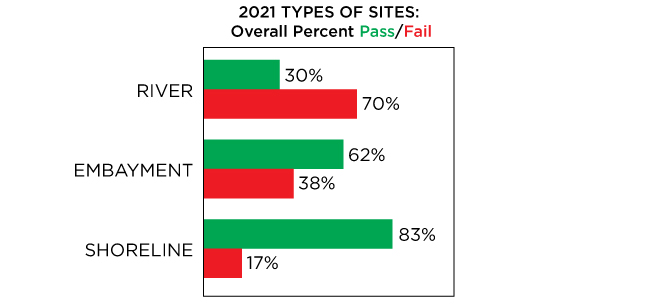2021 Bacteria Monitoring Stats
62 sites, 681 water samples,
21 trained volunteers
2021 Bacteria Sampling Data
Weekly Monitoring Data Maps
Westchester, NY & Greenwich, CT pdf xls
Queens & Nassau Counties pdf xls
Summary by Site pdf xls
Quality Assurance Project Plan pdf
Map Legend
Quick Links
Best and Worst
Summary of Findings
Eyes and Ears on the Water
Changing Weather Patterns and Impacts
Action Items
Select Year: 2024 • 2023 • 2022 • 2021 • 2020 • 2019 • 2018 • 2017 • 2016 • 2015 • 2014
Fecal Bacteria Monitoring
In 2021, Save the Sound collected and tested water quality from Greenwich, CT, through Westchester County, to Queens, and into Nassau County. Samples were analyzed for fecal indicator bacteria Enterococcus in marine water and E.coli in freshwater, which are used to determine if waters are safe for swimming. Click on each site on the map above to see what we found. The colors reflect average bacteria levels at each site. The “% Pass” and “% Fail” show how many samples passed or failed the single sample criteria for safe swimming in New York and Connecticut.
State Criteria for Safe Swimming
Samples greater than 104 CFU/100 mL Enterococcus are considered unsafe for swimming in marine water. Samples greater than 235 CFU/100 mL E. coli are considered unsafe for swimming in fresh water.
A weighted average (geometric mean) greater than 35 CFU/100 mL Enterococcus is considered unsafe for swimming in marine water and greater than 126 CFU/100 mL E. coli is considered unsafe for swimming in fresh water.
Summary of Findings
Overall Failure Rates Unchanged
Overall fecal contamination rates were the same in 2021 as in 2020 but the combination of dry weather and wet weather failures did see some adjustments. A decrease of 3% in dry weather failures occurred this year from 2020. However, the wet weather failure rate increased by 5% which created the same overall percentages as last year.
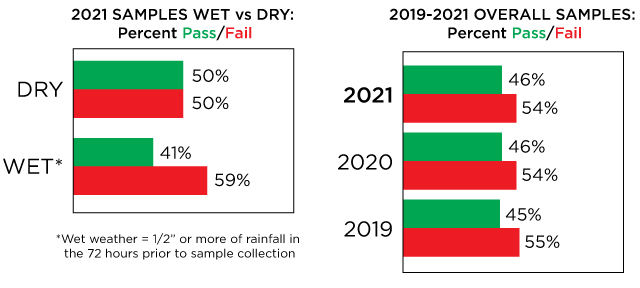 Failure is based on safe swimming criteria used in Connecticut and New York to monitor and manage beaches. Because wet weather causes pollution to flush off the landscape and into the waterways, and can trigger overflows of untreated sewage, Save the Sound reports on wet weather samples separately. This year, as in all past years, fecal contamination was higher after rainfall at most locations.
Failure is based on safe swimming criteria used in Connecticut and New York to monitor and manage beaches. Because wet weather causes pollution to flush off the landscape and into the waterways, and can trigger overflows of untreated sewage, Save the Sound reports on wet weather samples separately. This year, as in all past years, fecal contamination was higher after rainfall at most locations.
River Sites Show Slight Improvement
Rivers remain the most polluted sites in 2021, but there was a reduction in fecal contamination at some of the river sites. There was a collective 4% decrease in failure rate in rivers compared to 2020. This year’s failure rate of 70% is the lowest failure rate observed in rivers sampled since they received a 63% in 2017. A decline in failure rates at the Mamaroneck River, Beaver Swamp Brook and Sheldrake River sites contributed to the overall decrease. Despite some improvements in these three rivers, there was an increase in failure rates for the remaining rivers: Hutchinson River, Blind Brook, Gabblers Creek, Byram River and Guion Creek. There is still much work to be done to clean up these waterways. Many of these rivers running through our communities are carrying an unacceptable level of fecal contamination which poses a risk to human health.
Long Island Sound Sites Decline Slightly
Bays and Harbors (“Embayments”) and shoreline sites both experienced an increase in fecal contamination in 2021 from the previous year. When compared to 2020, embayments had a 4% increase in failed samples while shoreline sites had a 5% increase. These sites show variability over the years of sampling which may be related to them being tidal sites that are flushed with open Sound water twice a day.
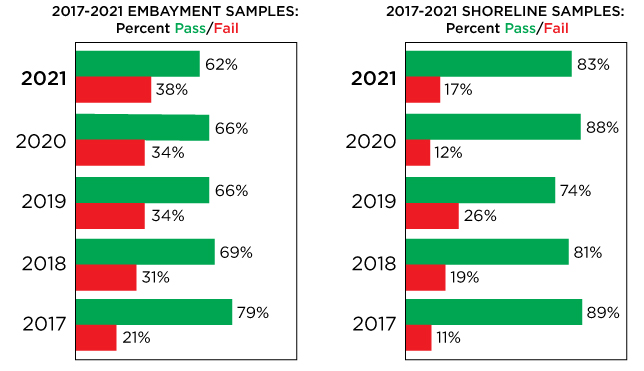
Eyes and Ears on the Water
A growing group of volunteer watchdogs works with Save the Sound to report potential pollution sources to our waters. These intrepid volunteers make a point of keeping vigilant for signs of pollution and reporting them to Save the Sound and others as appropriate for quick action. These reports, and subsequent corrective actions, have led to stemming the flow of untreated sewage into waters people come into contact in our region.
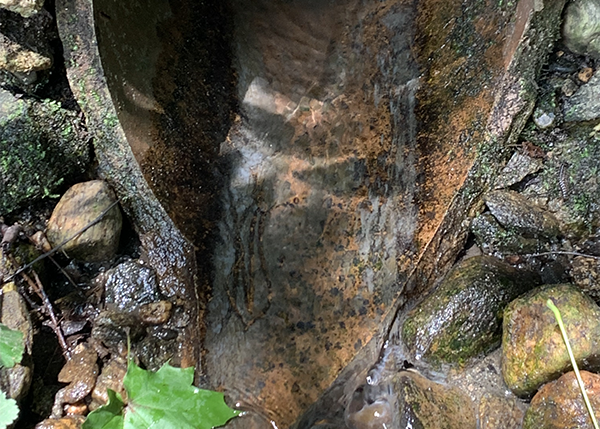 Illicit discharge into the Mamaroneck River reported to Save the Sound by volunteer watchdogs.
Illicit discharge into the Mamaroneck River reported to Save the Sound by volunteer watchdogs.
An example of the watchdog effort this year involved concerned residents living along the Mamaroneck River reporting potential pollution discharges into the water. Save the Sound staff promptly inspected the area, located a pipe discharging water during dry weather into the river, reported the location to municipal staff, then collected samples for E. coli. The results were very high for this indicator of fecal pollution. These data, in addition to field observations, were used to drive action to stop this pollution source into the Mamaroneck River. It is not the first to be found discharging into it, and likely not the last, but it will contribute to lowering the fecal contamination on this river.
We encourage all that are interested to read more about this initiative and consider becoming a watchdog!
Changing Weather Patterns and Impacts
Tropical Storms Elsa and Henri and Hurricane Ida brought staggering volumes of precipitation in short durations of time foreshadowing climate change’s human and environmental impacts. With all of that rain came extensive damage from flooding and environmental impacts. For example, these storms caused numerous reports of sanitary sewer infrastructure failures which led to raw and partially untreated sewage entering our waters making them unsafe for swimming and other activities. Over 115 million gallons of raw sewage mixed with polluted stormwater entered the Sound during and after Tropical Storm Elsa alone. Investments in sewer infrastructure will need to increase to assist in mitigating the impacts to our waterways as we experience more rain in the coming years.
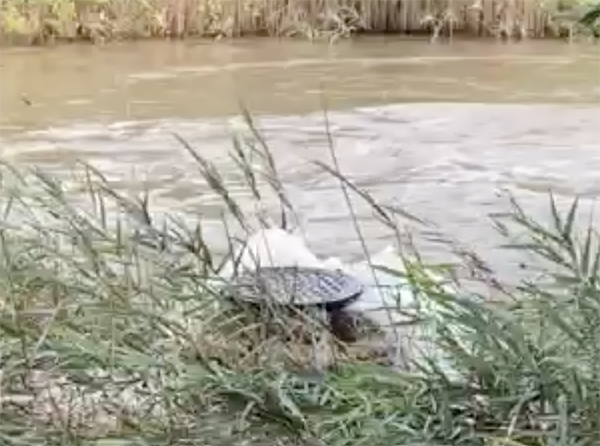 Sanitary sewer overflow from a manhole discharging untreated sewage into Blind Brook.
Sanitary sewer overflow from a manhole discharging untreated sewage into Blind Brook.
One of many sanitary sewer overflows that occurred during the impacts of Tropical Storm Henri. An old manhole in need of repair and the unacceptable inflow of rainwater into aging sewage infrastructure resulted in this discharge of raw sewage into a section of the Blind Brook in Rye, NY. Save the Sound is using the tools at our disposal – advocacy, education, water monitoring, legal actions, and nature-based solutions – to stop these pollution sources to our waters.
Best and Worst of 2021
Seven of the best locations in the study this year, none of which had a single failing sample, include Greenwich Cove, Larchmont Harbor, outer Mamaroneck Harbor, and numerous sites in New Rochelle.
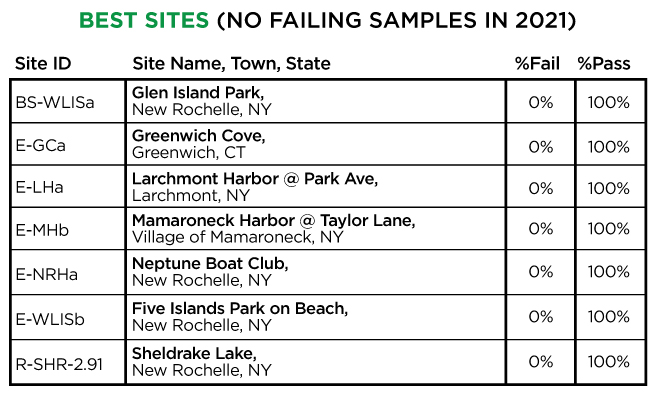
There were 8 locations that failed every time they were sampled including Udalls Mill Pond in Saddle Rock on Long Island, multiple sites on Beaver Swamp Brook and the Hutchinson River, and one on the Byram River in Connecticut. The Hutchinson River is once again the most polluted river we monitor, followed by Beaver Swamp Brook.
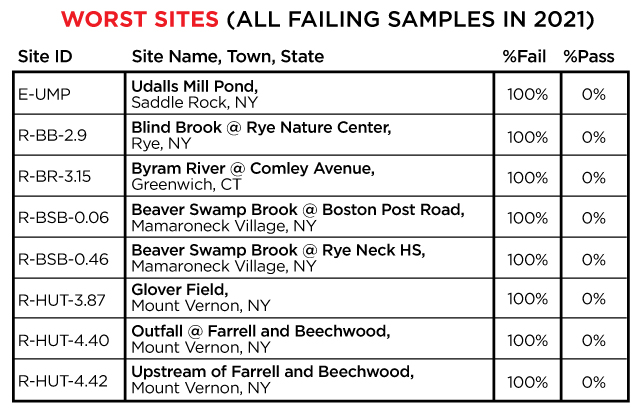
Be a Part of the Solution
As long as rivers, streams, and our coastline are still polluted, Save the Sound remains committed to restoring water quality where people swim, fish, and paddle. Save the Sound encourages all members of the public to be on the lookout for water pollution and report anything they see to their local health authorities and to Save the Sound at pollution@savethesound.org.
- Everyone can help reduce sewage pollution sources simply by conserving water, which will lessen the wear-and-tear on our water infrastructure and reduce sewage overflows by lowering the volume of water in the system.
- Homeowners need to repair the sewer lines that connect homes and businesses to municipal sewers, or maintain their septic systems.
- Dog owners should put pet waste in the trash, never in a catch basin or on the street.
- Every community and homeowner should work on strategies like creating rain gardens to help reduce runoff.
- If you see sewage overflowing in your community, please let us know by sending a photograph or video plus the time and location of the overflow to pollution@savethesound.org.

